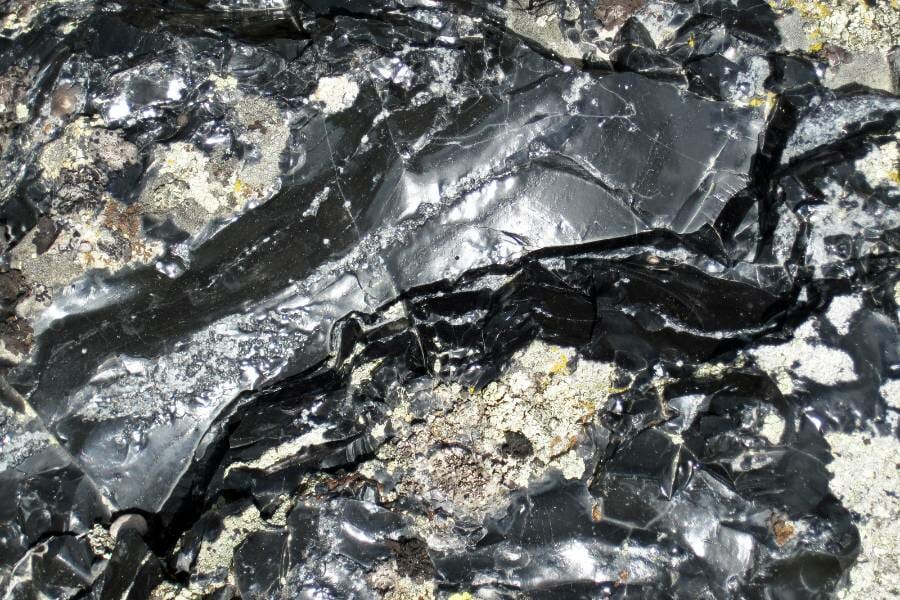If you are looking to find obsidian and haven’t had a lot of luck you just need a little guidance. This precious igneous rock isn’t always easy to find but the search can be a lot of fun! We’ve had a lot of success finding it and have some great options that just about anyone can use to add some obsidian to their collections.
Being volcanic in nature, obsidian isn’t found everywhere so you really need to be smart when you start your search. You might need to travel a bit but there are locations all over the world where it can be found.
It’s time to join in the obsidian hunt! Where and how to find obsidian is something anyone can learn and we just happen to have all the answers.
What is Obsidian?
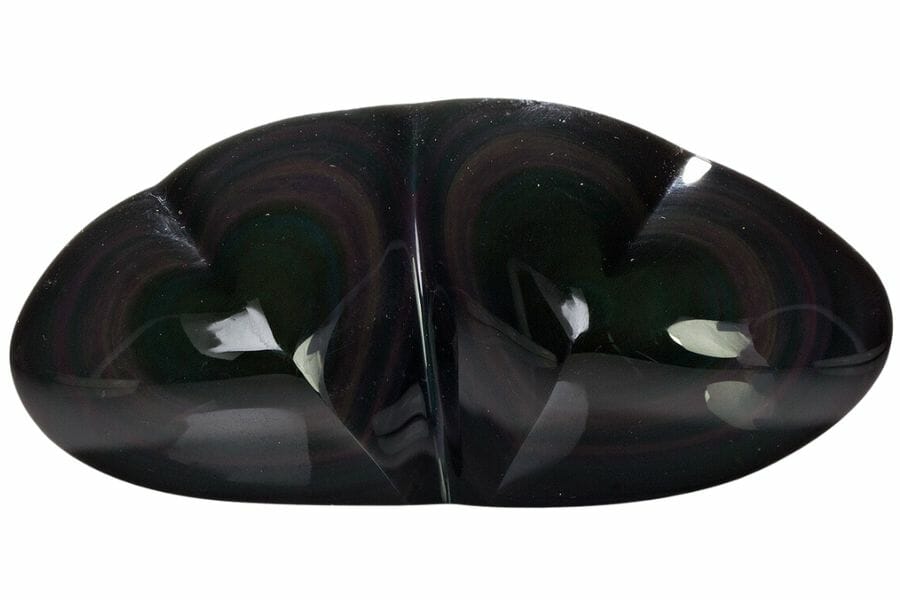
In order to understand where to find it you really need to know what it is and how it’s formed.
Obsidian is a naturally occurring volcanic glass that forms when lava cools rapidly without allowing the formation of mineral crystals. It’s an igneous rock that is primarily composed of silica (SiO2) and also contains small amounts of other elements, such as magnesium, iron, and calcium.
Dark in color, typically black or dark brown, due to the presence of iron and magnesium it’s known for its smooth, glassy texture and sharp edges when fractured, which have made it a popular material for tools and weapons throughout human history.
Obsidian is formed when felsic lava, which is rich in silica, cools rapidly upon contact with the atmosphere or water. This rapid cooling prevents the formation of the crystalline structure typically found in other igneous rocks, and instead, the lava solidifies into a glassy, amorphous state. The glassy nature of obsidian is due to its lack of a well-ordered internal structure, which is a result of the rapid cooling process.
Where is obsidian found?
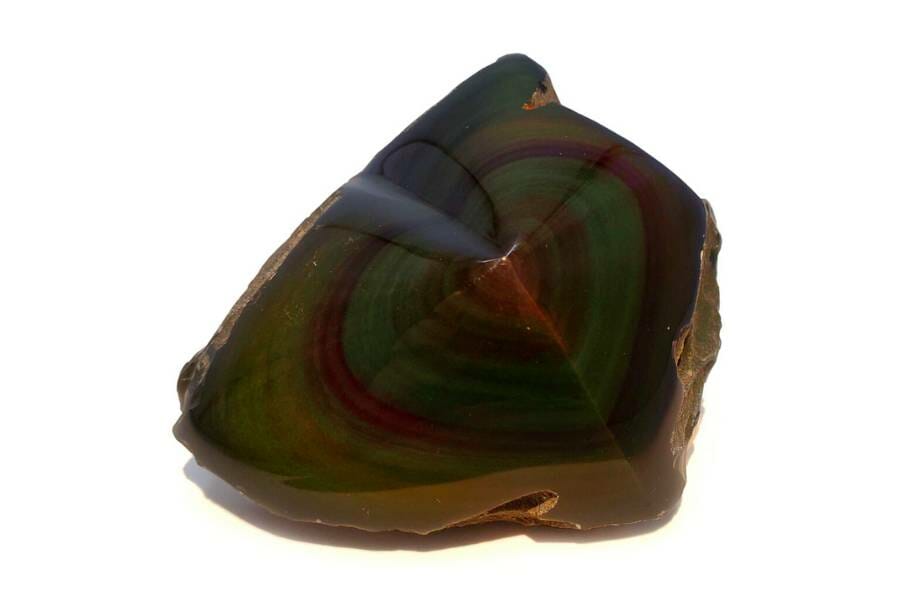
Obsidian is found only where volcanic activity occurs and where silica-rich magma has a high chemical composition. Obsidian-bearing volcanoes are generally found in or close to regions where the crust is unstable or where mountains are forming.
In the North American continent, obsidian is found in regions where the plate tectonics processes have produced the right conditions for volcanoes and the creation of obsidian. These include countries in the central and southern part of the continent.
Across the world, substantial concentrations of obsidian are found around volcanic regions where felsic lava flows occur. This includes areas like the Aeolian Islands off the coast of Italy, Mount Hekla in Iceland, and many places in the United States, Mexico, Japan, and other regions along the Pacific Ring of Fire.
Local Obsidian Hunting Guides
*CLICK ON THE STATE ABOVE TO READ THE FULL GUIDE*
Since there are so many great places you can try we wanted to put together some local guides to better direct your search. You can click on the state icon above and go to the local guide for obsidian there.
You’ll notice that most states don’t have a guide and that’s because obsidian is only found in very particular areas.
You can also click on the links below to go to the specific states:
Five of the best spots to find Obsidian in the United States
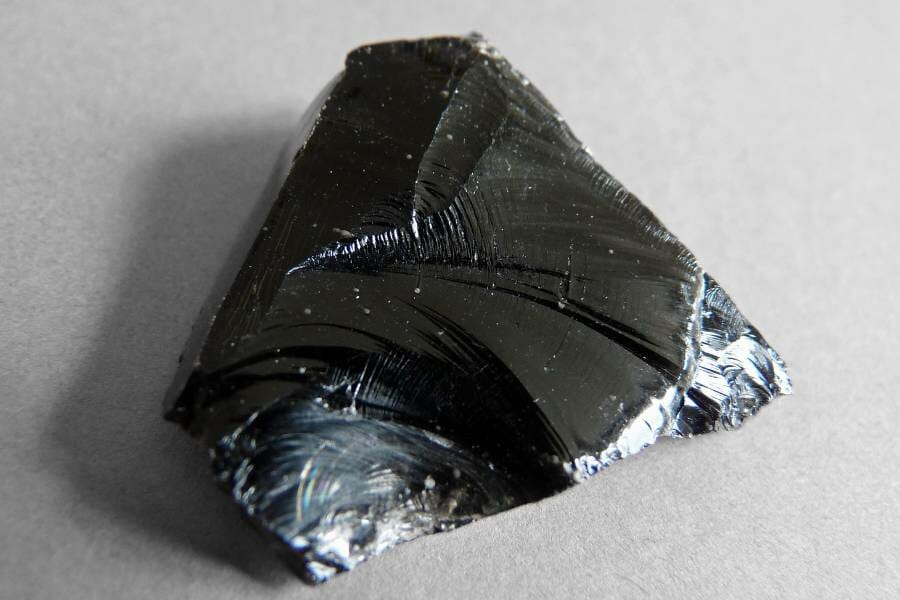
Warner Mountains, California
A fault block range known as the Warner Mountains is located in Northern California and borders Oregon to the north. The range spans roughly 90 miles, with a complex geology of sedimentary rocks overlain by basaltic volcanic rocks.
The range is a complex collection of fascinating rocks that contribute to shaping the local environment. Among the various types of volcanic deposits found in the Warner Mountains is the hard, glass-like obsidian.
There are four mines where the public can gather a variety of obsidian with a permit in Warner Mountains. These include Middle Fork Davis Creek, Pink Lady, Lassen Creek Rainbow, and Needles, in Northeastern California.
The luster of the rainbow obsidian from the Rainbow Mine and Middle Fork Davis Creek means it is in high demand. The most well-liked obsidian finds for rockhounds here are the pink obsidian from Pink Lady and the bundles of obsidian needles from the Needles Mine. The Needles Mine contains deposits of long obsidian needles, making the mines even more fascinating.
Rock hunting on sunny days between 11 a.m. and 4 p.m. offers the best opportunity for rockhounds to find the colored obsidian.
Obsidian Cliff, Yellowstone National Park, Wyoming
This is the United States’ most widely-scattered source of obsidian. Located along the trading routes from Western Canada to Ohio, this region has a long history of volcanic activity.
Obsidian is more concentrated at the bottom of the cliff. It gradually decreases to a higher concentration of pumice (a porous volcanic glass) at the top. Around 59 quarry pits and spots where rockhounds can hunt for this stone exist in the Obsidian Cliff Plateau.
Visitors can drive to Obsidian Cliff in the park and view the rock formations there, but they must not take any of them with them. The most distinguishing feature of the obsidian here is its sharpness.
It is sharp and cuts quite cleanly. Some surgeons employ scalpels made of obsidian. Other deposits can be found in Wyoming’s mountainous areas, such as Jackson Hole near the Teton Pass or the Green River region to the south.
Glass Butte, Oregon
This is the world’s largest high-quality obsidian deposit. Glass Buttes and the surrounding hills are situated off U.S. Route 20 at milepost 77. The region is distinguished by volcanic mountains and undulating hills covered in sagebrush.
Nestled in northeastern Lake County, the easily-accessible spot is owned and managed by the BLM. Each rockhound is permitted to collect about 250 pounds per year. Black obsidian is the most common stone here, even though some interesting varieties are found too.
It’s best to rockhound here in the spring through October; just have your necessary tools handy. Using a high-clearance 4×4 vehicle during the rainy season is advisable because the terrain gets extremely muddy.
Obsidian Ridge, New Mexico
The Obsidian Ridge is adjacent to the Jemez Mountains, a short drive outside Los Alamos. The geological history of this spot reveals that the state has several volcanoes, and its landscape shows indications of extensive volcanic activity.
The combined magma chambers of the “mega volcano” of the Valle Caldera and its volcanic mountain range, and the other volcanoes nearby, eventually erupted, collapsed, and formed what is now known as the Valle Caldera.
Thousands of obsidian shards are dispersed throughout the area, making the location the easiest and simplest rockhounding spot you’ll ever see. But note that collection is prohibited in national parks unless you have the right permits.
Big Southern Butte, Idaho
Located in central Idaho, the butte is one of the world’s biggest volcanic domes. It was formed when rhyolite magma drifting up from the hotspot about 300,000 years ago started forming a pool beneath the basalt.
The rock grew and cracked, with obsidian flowing out of the fissures. There are numerous obsidian deposits in the southern region of Idaho, including those at Jordan Creek, Kelly Canyon and American Falls.
Depending on the amount of snow and the state of the roads, the approximate season of use is from mid-May to October. Although the route is accessible to large cars, ATVs and UTVs are the best to access this spot.
Where you can find obsidian outside the United States
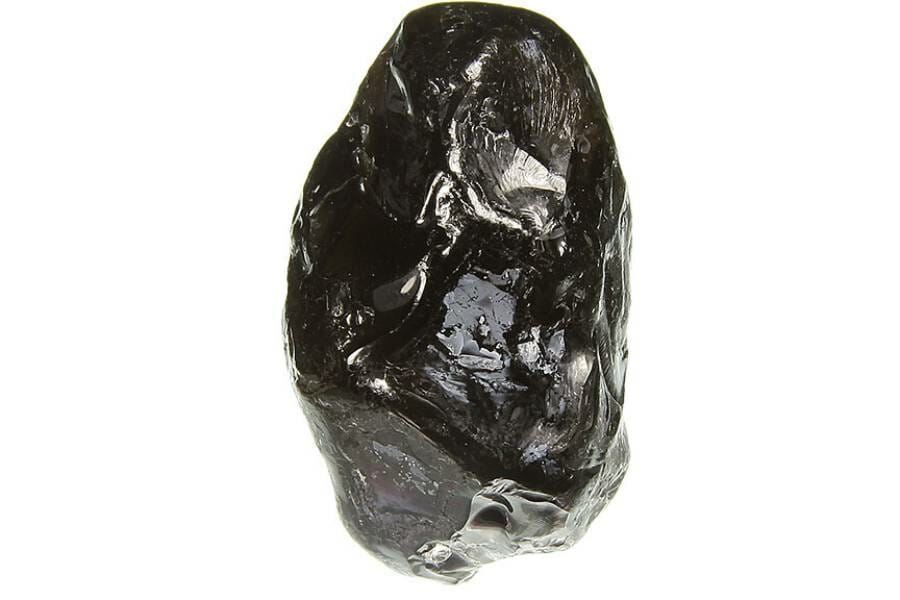
A substantial deposit of obsidian is found in the elongated Hekla Volcano, close to where the Eastern Volcanic Zone and the South Iceland Seismic Zone meet in Iceland.
The Aeolian Islands, which lie off the coast of Italy, have an active geological structure and have been the site of recent volcanic activity. Rockhounds can find pure obsidian only in Lipari, in the Vallone del Gabellotto neighborhood, close to Canneto.
The Vulcano and Stromboli are two active volcanoes in this area contributing to magma’s formation, leading to a large deposit of obsidian.
The central Andes areas of Argentina and Chile have a long history of volcanic arc activity. These areas remain a very good source of obsidian, while in terms of quality and quantity, Las Cargas and Laguna del Maule are the best areas for obsidian.
Other countries where it is found include regions with volcanic activity: Japan, Kenya, New Zealand, Greece, Hungary and Russia.
The different types of obsidian near you

There are different types of obsidian; this mineraloid’s trace elements or inclusions give it a wide range of colors. These include:
Black Obsidian
This is the pure black obsidian formed from the quickly cooled lava, producing glossy volcanic glass with its characteristic black appearance. Large amounts of black obsidian are dispersed throughout the Western parts of the United States and are easily accessible. Its application in jewelry is somewhat limited, but it makes for beautiful decorative items and is admired for its timeless appeal.
Sheen Obsidian
This type of obsidian has reflective qualities when polished. It sparkles and shines. It exhibits a sophisticated gold and silver “sheen” due to the existence of gas bubbles left over from the lava flow. When polished and cut, it becomes a stunning collector’s delight.
Mahogany Obsidian
This type of obsidian has distinctive reddish-brown patterns and streaks caused by magnetite or oxidized hematite (iron) during the rock formation. These mahogany patterns and streaks are on the stone’s base surface, which is black. The mahogany appearance is due to impurities.
Snowflake Obsidian
Snowflake Obsidian, also known as a “stone of purity,” is extremely attractive. It has a rich background with delicate white stars or snowflakes that occur in intricate patterns; this is its distinctive feature. The snowflakes occurring in intricate patterns are cristobalite — a stable form of silica.
Rainbow Obsidian
This type of obsidian looks like a standard black stone, but when polished and exposed to bright light, it exhibits bands of rainbow colors. This is due to magnetite nanocrystals in the stone. Rainbow obsidian is widely used in jewelry creation because when light reflects off minute air bubbles inside it, it shows a glossy sheen.
Apache tears
Named for the tears shed by the families of the Apache warriors who chose to ride over a cliff rather than be killed by US soldiers, these are spherical obsidian pebbles. They appear black when you hold them in your hands, but when you bring them up to a light, you can see they are translucent and dark gray-brown.
Even though they are not rare, they only occur in a few tertiary volcanic zones. They are formed when molten lava erupts into the air and quickly solidifies before it touches the ground.
How to locate obsidian while searching
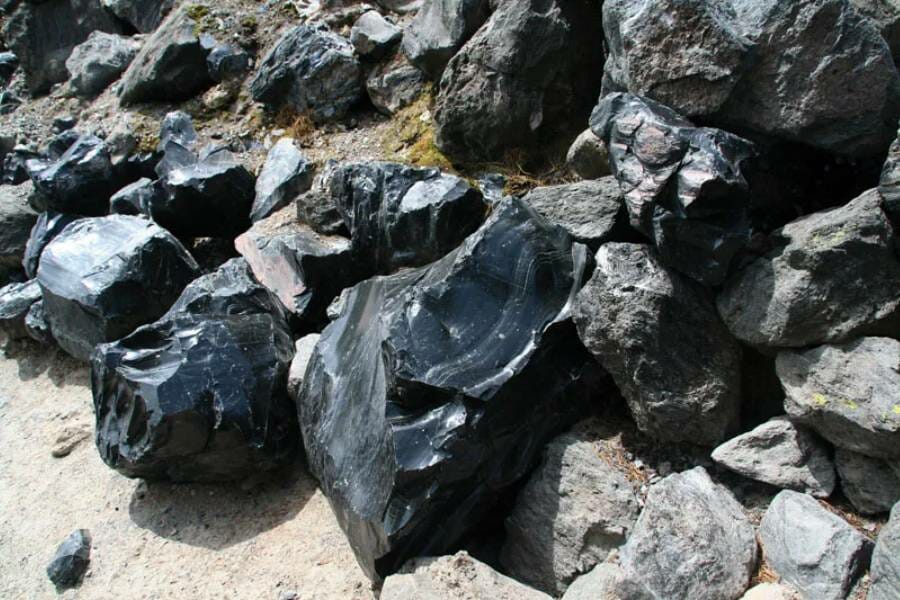
While the United States is home to several spots with obsidian deposits, understanding how and where it formed will be crucial to finding these specimens. Some of the common places where you can find obsidian in these areas include:
- Creeks and Lakes. Obsidian can be found in some creeks and lakes in the country because this rock forms when silica-rich lava quickly cools. Erosion may have also contributed to the dispersal of these stones during the flood.
- Mines and outcrops. This mineraloid can be found in mines, especially in spots close to regions of recent volcanic activities. While you may have to do some digging in some mines where it must have been buried underground over time, it can also be spotted on outcrops.
- Volcanic tubes. Since this mineraloid is associated with areas of recent geologic volcanic activities, the lava tubes through which the molten magma flowed out are good spots to find obsidian. The cavities and fissures that develop when hot lava and fumes explode, though only a few feet wide, may stretch over a few miles. Locating these volcanic tubes guarantees successful obsidian finds.
Tips to find obsidian near you
Some of what you need to know that will assist you in finding your cherished obsidian includes:
History and formation
Knowing that obsidian is formed as a flow rather than an explosive eruption before embarking on your rock hunting expedition is necessary. This allows you to only look for this mineraloid in the right places. Also, its formation within igneous rocks by extruding silica-rich molten magma straight into the water, followed by rapid cooling, should serve as a guide.
Features
This mineraloid is black despite its silicate composition; however, it can take on a variety of colors depending on the mineral inclusions and impurities present in it. The main distinctive feature of obsidian is its strong conchoidal fractures (a type of fracture resulting in a smooth, rounded surface) and brilliance.
Get a geological map
Getting a map showing the geologic history of volcanism in the mountainous areas of the country will assist you in finding the locations of obsidian. States like Oregon, California and Arizona are some of the states with favorable geologic history for obsidian rockhounding.
There are also mines and other spots for rockhounds to fuel their passion in these states and many more. The U.S. Geological Survey (USGS) is the starting point for searching for the best locations.
How to identify obsidian from the inside
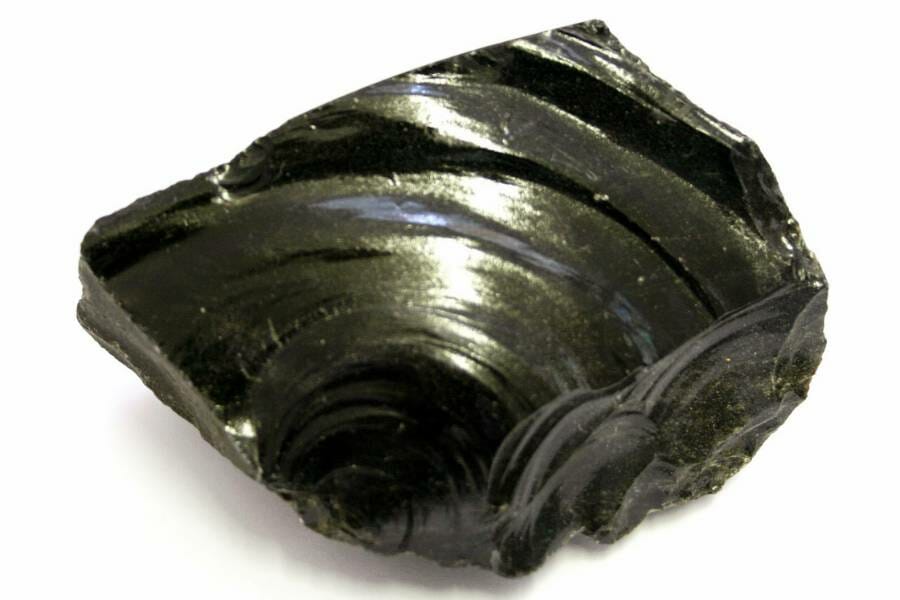
Obsidian is over 70% silica. Some types have snowflake patterns due to the occurrence of small, white, radially grouped crystals of cristobalite (snowflake obsidian).
It can also contain a pattern of gas bubbles from the lava flow aligned along the layers when the molten rock was flowing. These bubbles can produce a golden gloss (sheen obsidian).
Some obsidian has spherical clusters of needley clusters pointing to the center. They are opaque and translucent.
How to identify obsidian from the outside
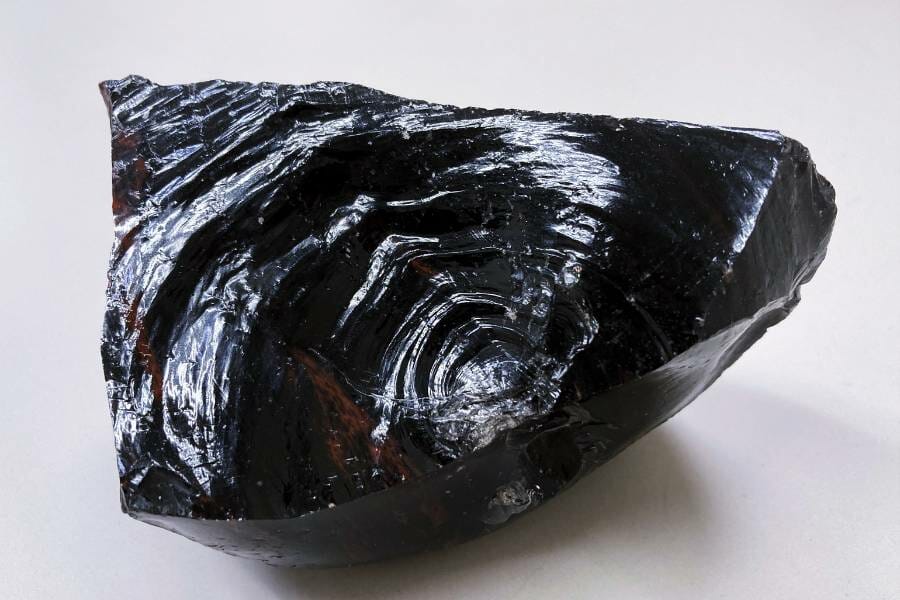
Obsidian looks like smooth glass on the outside. Its lack of a crystalline structure proves it is not a real mineral and contributes to its sharp fracture surfaces. One of the main distinguishing features of obsidian is its ability to break.
This breaking pattern is a type of fracture resulting in a smooth rounded surface, and it shows that it can fracture into sharp, curved fragments with razor-thin surfaces. Obsidian fractures like glass and other types of natural rocks.
The intersections of conchoidal fracture surfaces could be razor-sharp. This feature makes it easier to identify them from the outside. It is primarily black, but minute impurities and small crystals produce a variety of different colors.
It can come in red and brown variants when hematite (iron oxide) is present, and it sometimes has a golden sheen when microscopic gas bubbles are present. It is a smooth, shiny crystal, but you may find it more brittle and less hard than quartz, with a 5 to 6 on the Mohs scale.
These exquisite and peculiar features of obsidian make it easy to spot for both amateur and professional rockhounds when hunted at the right location and time.

